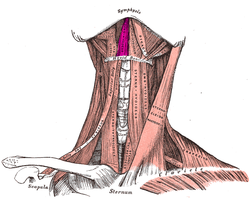Geniohyoideus
| Geniohyoid muscle | |
|---|---|

Anterior view. Geniohyoid muscle labeled at upper center left
|
|

Extrinsic muscles of the tongue. Left side.
|
|
| Details | |
| Origin | Inferior mental spine of mandible |
| Insertion | Hyoid bone |
| Artery | Branches of the lingual artery. |
| Nerve | C1 via the hypoglossal nerve |
| Actions | Carry hyoid bone and the tongue upward during deglutition |
| Identifiers | |
| Latin | Musculus geniohyoideus |
| Dorlands /Elsevier |
m_22/12549193 |
| TA | A04.2.03.007 |
| FMA | 46325 |
|
Anatomical terms of muscle
[]
|
|
The geniohyoid muscle is a narrow muscle situated superior to the medial border of the mylohyoid muscle. It is named for its passage from the chin ("genio-" is a standard prefix for "chin") to the hyoid bone.
It arises from the inferior mental spine, on the back of the mandibular symphysis, and runs backward and slightly downward, to be inserted into the anterior surface of the body of the hyoid bone. It lies in contact with its fellow of the opposite side. It thus belongs to the suprahyoid muscles. The muscle is supplied by branches of the lingual artery.
The geniohyoid muscle is innervated by fibres from the first cervical nerve travelling alongside the hypoglossal nerve. These fibers are called ansa cervicalis.
It may be blended with the one on opposite side or double; slips to greater cornu of hyoid bone and Genioglossus occur.
The geniohyoid muscle brings the hyoid bone forward and upwards. This dilates the upper airway, assisting respiration. During the first act of deglutition, when the mass of food is being driven from the mouth into the pharynx, the hyoid bone, and with it the tongue, is carried upward and forward by the anterior bellies of the Digastrici, the Mylohyoidei, and Geniohyoidei. It also assists in depressing the mandible
The inclined position of the geniohyoid muscle has been contrasted to the horizontal position in neanderthals.
Hyoid bone. Anterior surface. Enlarged.
Sagittal section of nose mouth, pharynx, and larynx.
...
Wikipedia
